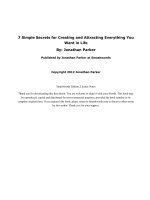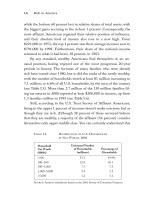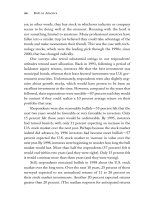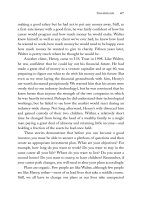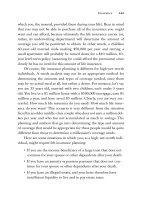Rich in America Secrets to Creating and Preserving Wealth PHẦN 10 pps
Bạn đang xem bản rút gọn của tài liệu. Xem và tải ngay bản đầy đủ của tài liệu tại đây (789.64 KB, 50 trang )
100%
90%
80%
70%
60%
50%
40%
30%
20%
10%
0%
Quoted
by media
Well-known
Recommended
by friends
Street smart
Top
peformer
Keeps me
informed
Well-
educated
Understands
me
Is trustworthy
Women
Men
F
IGURE
7.1 I
MPORTANT
A
TTRIBUTES OF A
F
INANCIAL
A
DVISOR
Base = respondents who use professional advisors
S
OURCE
: U.S. Trust Survey of Affluent Americans XII, June 1997
220
07 Chapter Maurer 6/20/03 5:21 PM Page 220
about how many clients they handle and the quality of their
backup. People managing hundreds of other relationships may
have a difficult time giving you the amount of time you want
and need.
• Understand how you will receive your advice. Will it be in
person? Over the phone? By mail? Over the Internet? How
frequently can you expect to have meetings? When you have
a question, whom should you call?
• What type of statements and reports will you receive? Ask for
samples. If the samples don’t meet your requirements, find out
if the firm can produce the type of reports you need, and how
much this will cost.
• Don’t let fees be your primary concern. Examine firms without
regard to fees and then select your finalists. Only then should
you examine their fees and compare them to the alternatives
to make sure they are reasonable. Try to understand how all
the fees are calculated. For example, consider the investment
of cash in your accounts: Almost every firm uses money market
funds to invest cash awaiting investment because these funds
offer competitive yields and provide instant liquidity. Most
large firms use proprietary funds to meet this need, giving
them an additional (but reasonable) form of compensation.
But on occasion, a firm may use money market funds unfairly
to increase their compensation by charging higher-than-
average fees. You must do your homework to find out what
you’ll be charged for, and why.
• In addition to understanding the firm’s stated fees, make sure
the fee payment method does not set up insurmountable con-
flicts of interest. If you choose an investment manager who
trades through a captive broker-dealer, not only will there be
a fee charged for managing your portfolio, but also a fee to
How to Choose a Financial Advisor 221
07 Chapter Maurer 6/20/03 5:21 PM Page 221
the firm on the trading activity itself. This is business as usual;
you’d pay a similar fee to another firm. However, if the trade
involves buying or selling the inventory of a broker-dealer,
such as municipal bonds, it should be closely scrutinized.
• Make sure all clients pay similar fees. If you sense that a
firm discounts its fees, ask if they will guarantee that you
will receive the lowest fee available for similar services.
• If you are looking for premium service and competitive results,
you must be willing to pay appropriate fees.
• Understand the management of the firm and its culture. If
major changes in management occur while you are a client,
investigate further. For example, does the new management
have appropriate experience in the business of the firm? Firms
involved in mergers or acquisitions also require additional
scrutiny. Why was a firm sold or why did it merge? Do the
reasons for the merger support your interest in the firm? Will
the principals remain active? Usually, mergers make sense for
everyone—clients, employees, and shareholders—but some-
times they fall apart, and the upheaval can adversely affect
your finances.
• Find out how your professionals are compensated. Are their
interests aligned with yours? Could they make money at your
expense?
• Don’t be timid. Ask questions. No question is too dumb.
How your questions are answered, both in terms of content
and the respondent’s demeanor, will give you insight into
the firm’s culture.
Virtually every firm in the personal financial services business has
positioned itself to help clients in the investment planning process.
This process is centered on driving clients to the appropriate asset
222 Rich in America
07 Chapter Maurer 6/20/03 5:21 PM Page 222
allocation decisions based on their particular circumstances. Accord-
ing to many studies, asset allocation alone is responsible for more than
90 percent of portfolio performance.
As it prepares plans, a firm gathers information about you, in-
cluding your resources, personal circumstances, time horizon, age,
income needs, liquidity requirements, and tax concerns. The firm also
spends time understanding your return expectations and risk toler-
ance, and then uses its modeling tools to formulate the strategy it
feels is best for you.
You must find out if the firm is willing to educate you along the
way. Firms that simply ask you to fill out a form and then hand you a
plan probably haven’t spent sufficient time to understand you and your
needs. Most firms in the investment management business don’t charge
for this personal analysis, because it helps bring in clients so they can
sell them their main offerings. As previously mentioned, there are new
firms that specialize in investment planning combined with some ver-
sion of financial planning. They charge a supervisory fee for providing
the service and placing the assets with independent (from them) port-
folio managers.
Become aware of the products and services you are likely to pur-
chase from your chosen investment firm; that knowledge will help you
interpret the advice they give. For example, if the firm is in the invest-
ment management business and they suggest that you only need to
invest in the value sector (stocks that are known for their steadiness, as
opposed to growth stocks, which are riskier but potentially more prof-
itable), this may be a danger signal. Pushing a specific type of invest-
ment indicates they may be biased—particularly if it turns out the firm
has a stake in the value stocks or the product they are recommending.
You also should inquire whether the firm will take into account
your other assets, such as corporate benefit plans. Will they help you
make decisions within those plans, even though the firm will not be
managing those assets nor receiving a fee?
How to Choose a Financial Advisor 223
07 Chapter Maurer 6/20/03 5:21 PM Page 223
Some investment consulting firms offer investment planning,
manager selection, and performance measurement for a fee, but do not
get paid for providing investment services per se. This type of arrange-
ment was generally provided only to the very affluent because the cost
of the service is based on time spent and is usually not justified unless
the asset base (the amount you invest with them) is large. However,
today many advisors provide this service to investors with as little as
a few hundred thousand dollars; the fee is based on a minimum and a
percentage of the assets under supervision. This combined fee is often
high, but may well be the price to be paid to receive unbiased advice.
Also, if you are a self-directed investor, you can find many new tools
and services on line to guide you through this process.
Still, most likely you will be dealing with brokers, registered invest-
ment advisors (RIAs), or banks and trust companies. Their fees are typ-
ically based on the value of your assets under their supervision, and will
vary based on asset class and the use of proprietary products versus
nonproprietary products (products that they own versus products man-
aged by another firm). Some firms will charge a minimum fee for
investment planning and then additional charges if they also help you
implement that planning. Or, they may apply the initial fee against
future fees if you purchase additional services. Let’s look at the various
types of financial advisors.
Types of Financial Advisors
Brokerage Firms
Brokerage firms, which buy and sell stocks, bonds, and other products,
may or may not charge separately for investment planning. Histor-
ically, they have billed for their services on a pay-as-you-go basis. In
other words, you pay a fee to the firm for each transaction. In turn,
the brokerage firm pays the broker a percentage of the transaction fee
as compensation.
224 Rich in America
07 Chapter Maurer 6/20/03 5:21 PM Page 224
Recently, both brokers and clients have come to realize that pay-
ing by the transaction can give the appearance of a conflict of interest:
The client may perceive the broker’s advice to be motivated by a desire
to generate transaction-based revenue. Therefore, many brokers now
offer managed accounts in which you pay the broker a percentage of
the assets under supervision; in exchange, the broker will provide you
with both proprietary and nonproprietary products as appropriate.
Such investment vehicles can include individually managed
accounts or mutual funds, as well as a variety of alternative investments,
including access to hedge funds and venture capital products. These
asset-based fees, which cover most services, can run as high as 3 per-
cent to as little as 0.50 percent—the larger the pool of assets under
supervision, the lower the percentage fee charged. These fees also may
cover additional free services, but some of the underlying products
(such as alternative investments) may carry their own fees. Thus, it is
important to understand what is and isn’t covered in the fee proposal.
The larger brokerage firms have begun positioning themselves to
offer a much broader range of options, from trust services to banking
services. You need to investigate whether what appears to be a one-stop
shop has actually devoted the requisite resources to be able to deliver
these services competently and in a personalized fashion. If it has, you
can feel confident their traditional broker, now called a financial advi-
sor, is in a position to serve as trusted advisor and wealth manager.
Registered Investment Advisors
These advisors come in all shapes and sizes, from large national firms
with substantial resources to single practitioners. After registering with
the Securities and Exchange Commission, all an advisor need do is
hang up a shingle and go into business. Recently, their ranks have
begun to include accountants, lawyers, financial planners, insurance
agents, and all of their firms. RIAs can serve as investment counselors,
actually investing your assets directly, or consultants, helping you to
How to Choose a Financial Advisor 225
07 Chapter Maurer 6/20/03 5:21 PM Page 225
choose other managers. These days almost all advisors will help you
find other managers or products that complement their own particu-
lar investment management style. Many people choose to do business
with small RIA firms because the principals are actively involved in
the business, and/or because they don’t like dealing with the size and
bureaucracy of a large broker or bank.
If you decide to do business with a small firm, you must think
about what would happen if the principal became unavailable, as well
as what kind of record-keeping and backup systems the firm main-
tains. You also should be concerned with the depth and quality of the
research the firm provides, given such limited resources. Many small
firms subscribe to wonderful services and can effectively replicate the
resources of large firms. As well, most RIAs affiliate with brokerage
firms or banks to hold their clients’ assets and to provide record keep-
ing. If you have assets with multiple custodians or brokers, your reg-
istered advisors can employ technology that will take feeds from the
various custodians and brokers and consolidate the record keeping.
RIA fees are usually based on the size of assets under supervision.
Underlying fees for custody, trading, and asset management are gener-
ally passed on to you, the client. Many fee arrangements are unique to
dealing with RIAs, so you should thoroughly investigate both the
direct and indirect charges involved.
Banks and Trust Companies
Today there is little difference between the operations of banks and
trust companies and brokerage firms because of recent changes in leg-
islation and regulation that have made it possible for the appropriate
divisions of banks and brokerages to trade securities, offer financial
advice, take deposits, and make loans all under one roof. There also is
little difference between fees charged by banks, brokers, and RIAs.
The difference in fees is on a firm-by-firm basis rather than by cate-
gory of firm.
226 Rich in America
07 Chapter Maurer 6/20/03 5:21 PM Page 226
Historically, banks and trust companies have charged an assets-
based fee for services that included investment planning and invest-
ment management services. Until recently, they only used proprietary
investment products, but now almost all banks and trust companies
offer a mix of proprietary and nonproprietary products.
Banks and trust companies have generally kept their clients’ assets
in custody in the bank rather than in brokerage accounts (see the section
on custody, Chapter 1). Another subtle difference between bankers
and brokers is that banking has traditionally been a relationship busi-
ness, while brokerage has been a transaction business. In other words,
bankers have tended to develop client relationships and charge fees,
but not call clients to push products; however, brokers do push prod-
ucts. However, this distinction is blurring with changes in legislation,
regulation, and the business environment.
Selecting and Working with
Investment Managers
Managing your managers is another consideration. When you have
completed your investment planning, you will need to select invest-
ment managers to implement your strategies. You can do this on your
own, but more likely than not you will use the services of one of the
firms discussed in the previous section.
Whether you use a firm or do it yourself, the process will involve
quantitative and qualitative research. You will want to choose experi-
enced managers who are capable of producing consistent, first- and
second-quartile risk-adjusted returns within their asset class, who have
disciplines that allow for tax efficiency, or risk-adjusted after-tax returns
(in the case of hedge funds), and who agree with their firm’s invest-
ment process, compensation structure, and culture.
Once you select a firm, you should track it to spot significant
changes in any of the above criteria. For example, changes in the firm’s
investment process may be a danger signal that its current policy is not
How to Choose a Financial Advisor 227
07 Chapter Maurer 6/20/03 5:21 PM Page 227
working. If you selected the firm because of that very policy, you may
wish to switch.
Fees
Fees are another important consideration when you are selecting and
working with managers. Table 2.6 on page 61 provides average fees for
different asset classes for separately managed accounts. It is based on a
$5 million account. Smaller accounts may have higher percentage fees
and larger accounts lower percentage fees. Fees are calculated differ-
ently for nontraditional asset classes, such as venture capital and hedge
fund management. For these asset classes, managers receive a manage-
ment fee of about 1 percent, and also receive a carried interest or a share
of the profits.
Many venture capital and hedge fund managers charge a fee known
as 1-and-20, or 1 percent for management plus 20 percent of the
profits. As shown in the above chart, most traditional equity managers
receive only the 1 percent fee. However, if a hedge fund produces a 12
percent return, the manager will receive the 1 percent management fee
plus a carried interest of 2.4 percent, for a total fee of 3.4 percent.
Hedge fund and venture capital managers receive this carried interest
because traditional wisdom has it that the few managers who possess
such specialized skills can charge a higher fee.
Similar fee arrangements, including management fees and profit
sharing (but usually at lower levels), also apply in the real estate and
leveraged buyout asset classes. For example, a real estate investment
fund may share in 20 percent of the profits—but only after the
investor receives an initial 8 percent return. The 8 percent minimum
return before profit sharing is known as the hurdle rate. In that case, if
the investment produced an annualized return of 12 percent per year
after the 1 percent management fee, the manager would receive, in
addition to the 1 percent, a carried interest of 20 percent of 12 per-
228 Rich in America
07 Chapter Maurer 6/20/03 5:21 PM Page 228
cent, or 2.4 percent. However, the returns were less than 8 percent,
the manager would receive only the 1 percent management fee. The
investor receives the 8% hurdle rate before the manager receives any
payment.
Most nontraditional asset class managers have held their clients to
very high minimum investment requirements. It is not unusual for a
hedge fund manager to require a minimum investment of $5 million.
Even if an investor is worth $50 million and wanted to invest 20 per-
cent, or $10 million of his or her assets, in nontraditional asset classes,
investing in $5 million minimums does not allow sufficient diversifi-
cation within those classes and within managers. Someone worth $5
million or less couldn’t participate at all.
As a result, an entirely new investment management business has
developed called fund of funds. This arrangement enables smaller in-
vestors to invest in the nontraditional asset classes by participating in a
fund that itself invests in a number of different hedge funds, venture
capital funds, or leveraged buyout funds. Fund of funds managers per-
form due diligence on the underlying managers and put together a com-
plementary portfolio of investment styles and sectors; these managers
charge a fee of 1 to 2 percent, and sometimes charge a carried interest of
2 to 5 percent with or without a hurdle rate. It becomes expensive for
smaller investors to participate, but given the returns available in some
of the nontraditional asset classes, it can be a price well worth paying.
Also, consider that banks, brokers, and RIAs all have proprietary
investment products that they are likely to recommend (and they will
demonstrate how these products stack up against the competition). As
mentioned, most firms also offer nonproprietary products manufac-
tured by competing investment management firms. Some firms will
receive a portion of the fee from the underlying investment firm to
distribute its product and service clients. Sometimes the underlying
firms will not share fees, and the primary firm will simply charge extra
for nonproprietary products. Generally speaking, the proprietary prod-
How to Choose a Financial Advisor 229
07 Chapter Maurer 6/20/03 5:21 PM Page 229
ucts will have a price advantage over the nonproprietary products, and
that will have to be factored into your decision-making process.Trans-
parency here is important, and you should look to work with firms
whose process and fees you can understand.
Monitoring the Investment Management Process
After you choose advisors, you’ll want to monitor the investment
management process. Usually, the firm that guided you through your
investment planning will be best positioned to help you do this. You
will need to observe the performance of your investment managers
for performance and changes in process or in their firms as a whole.
You will also need to rebalance your asset allocation quarterly or semi-
annually, based on the investment results from different asset classes.
Conventional wisdom used to be that investment planning had to be
done every two to four years. But in our rapidly changing geopolitical
and economic environment, you should regularly review and challenge
the assumptions used in your investment planning process.
If you’re consistently dissatisfied with your results, sometimes the
difficult decision must be made to fire your advisor. The task can be
very traumatic because you must sever a relationship. I have seen many
intelligent investors retain their advisors and cope with a mediocre
performance simply because they can’t bear to fire them. Don’t fire
your advisor if you look at just one statement and think you’ve lost too
much. It may be that others have lost more, or that your advisor has a
plan that hasn’t yet taken effect.
Still, there are times you should grit your teeth and take care of
business. Perhaps your advisor has developed a bad track record over
the last few years, or maybe he or she has not able to change with the
investing environment. Unless your advisor can make convincing
arguments that the market will come back his or her way, you
have reason to be suspicious. For example, after the technology crash
230 Rich in America
07 Chapter Maurer 6/20/03 5:21 PM Page 230
of 2000, many advisors continued to recommend their clients buy
these stocks at what they called bargain basement prices; yet many
of these stocks continued to drop another 50 percent or more, and a
number of them went out of business.
Sometimes even successful advisors can give you reason to won-
der. Their record is good, but they may in turn become susceptible to
the challenges that accompany success. Perhaps the firm has grown
too fast, and what was once a small boutique now requires a great deal
of management. Remember, the number of good investment profes-
sionals who are also good managers is limited. You should certainly
leave an advisor when it becomes clear to you that he or she no longer
is using good common sense, or the performance will never recover.
As you can see, managing your wealth requires dedication, dis-
cipline, knowledge, and a trusted advisor to help you coordinate your
wealth management needs. But the right advisor can provide you with
immense peace of mind.
Coordinating Your Planning
Financial Planning
Financial planning requires the analysis of your current financial con-
dition in order to develop a plan to meet your short- and long-term
financial and related objectives. Virtually every firm in the personal
planning business is involved in financial planning: Brokers, RIAs, and
banks and trust companies are joined by accountants, lawyers, and insur-
ance agents.
Financial planners need to be proficient in all areas of planning,
and should also have extensive experience dealing with a wide variety
of issues, from how to handle concentrated stock positions to dealing
with the alternative minimum tax and the generation-skipping trans-
fer tax. Firms that offer computer-generated financial plans generally
How to Choose a Financial Advisor 231
07 Chapter Maurer 6/20/03 5:21 PM Page 231
don’t have the experienced personnel to do customized financial plan-
ning for the truly affluent. Planners also should be in a position to help
you implement their recommendations. For example, if your planner
recommends a second-to-die insurance policy, he or she also should
identify potential insurance agents and review the policy recommen-
dations, carriers, and pricing. Even the best plan fails unless it is put
into action, and the planner should stay engaged throughout. Fees
can run from a few hundred dollars for a computer-generated plan to
$25,000 or more for sophisticated planning by true professionals.
Estate Planning
Estate planning allows you to meet your objectives for the disposition
of your assets during your lifetime and at and after your death. Estate
planning has historically been handled by estate planning lawyers, bank
trust departments, and life insurance agents. As with investment plan-
ning and financial planning, virtually all financial services firms have
now positioned themselves to offer estate planning recommendations.
However, lawyers are the only professionals who can prepare wills
and trusts, as well as the other documents that are required in an estate
plan. To deal with estate planning properly, you need a team consist-
ing of an estate planning lawyer, a financial planner, and perhaps an
insurance agent. Estate planning lawyers charge by the hour; fees can
run from $100 an hour to more than $500 an hour based on experi-
ence and location. In seeking out an estate planning attorney, relevant
experience is a key consideration.
Retirement Planning
Retirement planning allows you to retire based on a predetermined life
style at an age you choose, and it is a subset of the financial planning
discipline. A retirement plan should be reviewed regularly as part of
232 Rich in America
07 Chapter Maurer 6/20/03 5:21 PM Page 232
the financial planning cycle or whenever you contemplate a change in
employment. If you have funded retirement plans such as a 401(k),
they should be reviewed on the same cycle as your investments. It is
vital to coordinate all your retirement options as retirement approaches.
Retirement planning should be performed by your financial planner
and the same guidelines apply.
Income Tax Planning
Income tax planning and preparation, which allow you to conduct
your activities in a tax-efficient manner, is another continuous process.
Reviewing income tax projections early in the year, in the fall, and in
December makes sense, as does timing these reviews to estimated pay-
ments if you are self-employed. Income tax preparation is provided by
CPAs and a few bank trust departments.The process is straightforward
and is generally billed by the hour with rates running from $100 to
$300. Make sure your provider can efficiently produce your tax projec-
tions. Many CPAs also can offer a light audit of your broker or custo-
dian to make sure you have received all of the interest, dividends, and
principal disbursements to which you are entitled. Your tax planner’s
input is essential in investment, financial, and retirement planning.
Insurance Planning
Insurance planning and implementation permit you to purchase the
appropriate amounts of life, property, casualty, and liability insurance
in an efficient manner. Property, casualty, and liability insurance should
be reviewed every two to three years, or when there is a change in your
circumstances, such as the purchase of major art, jewelry or a new
residence. If life insurance or annuities are part of your investment
management plan, they should be reviewed on the same cycle as your
investments. You will need insurance agents to help you implement
How to Choose a Financial Advisor 233
07 Chapter Maurer 6/20/03 5:21 PM Page 233
the recommendations of your financial planner. Your financial planner
usually can help you find a good insurance agent; you may need both
a life agent and a property and casualty agent. These agents receive a
commission on the products they sell.
Private Banking
Private banking often is the best option for handling your personal
banking requirements. Private banking is provided exclusively by banks.
Turnover is the bane of personal service, so find a private bank with
bankers who plan to stay there for years. In an era of impersonal busi-
ness, this service allows you the pleasure of picking up a phone and
obtaining a loan, stopping a check, or arranging whatever service is re-
quired with someone you have known and worked with for years.
U.S. Trust Survey of
Affluent Americans Results
In 1996, the U.S. Trust survey asked affluent men and women various
questions to compare their attitudes toward their finances and their
advisors. When asked to rate how well women and men perform 14
different tasks related to taking care of a family’s financial matters,
many women and men felt both sexes were equally capable of doing
these jobs. When they discerned a difference in how the sexes handle
money, men and women tended to agree about their individual
strengths. Both the women and the men surveyed felt men were better
at minimizing the taxes they must pay, developing a financial plan for
the future, selecting good investments, choosing a wise financial advi-
sor, and researching major purchases. The men also thought they were
better at these jobs. The women surveyed felt they were better than the
men at finding bargains, keeping good records, paying bills on time,
getting good value for the money they spend, and sticking to a budget.
The men also agreed that women were better at these five tasks.
234 Rich in America
07 Chapter Maurer 6/20/03 5:21 PM Page 234
For the most part, those surveyed felt that the most important
reasons to value money are that it allows you to live comfortably and
that it provides you with security. Affluent women felt more strongly
than men that money is also important because it enables you to give
advantages to your children, allows you to enjoy life’s luxuries, and per-
mits you to leave an inheritance to people you care about. Both men
and women felt that the least important reasons to value money were
that money makes it possible for you not to work too hard, and it is a
good measure of your success.
The financial goals of both men and women are similar: to have
enough money to be financially secure, to be able to enjoy a comfort-
able retirement, to have enough money to lead your current lifestyle, to
be able to live off the investment income, and to have enough money
to travel. However, women place more importance on providing for
their children’s education, on saving, and on providing an inheritance
to family members.
When it comes to professional advice, women (75 percent) rely on
it more than the men (53 percent) to help them determine the best
course of action with regard to financial matters. When asked to rate
the importance of one (or more) professional and/or nonprofessional
sources of financial advice, a large majority of women—65 percent—
considered their husbands to be their most important source. Thirty-
two percent said CPAs were also important, 30 percent liked certified
financial planners, and 28 percent cited investment managers or attor-
neys. Far fewer men (26 percent) considered their wives an important
source of financial advice. When asked who they considered their
most important source, 24 percent cited CPAs, 19 percent said invest-
ment managers, 16 percent said certified financial planners, and 15
percent cited attorneys.
When choosing a financial planner, the following characteristics
were deemed very important by women: trustworthiness, understand-
ing their situation and concerns, and a good education. Only trust-
worthiness ranked as highly for the men. In fact, it was the only
How to Choose a Financial Advisor 235
07 Chapter Maurer 6/20/03 5:21 PM Page 235
characteristic that more than 75 percent of the men surveyed thought
was very important.
Affluent women tended to be more risk-averse than men. When
offered a choice between an investment offering lower-than-average
returns but considerable safety of principal, and an investment offer-
ing better-than-average returns but some risk of losing the principal,
54 percent of the women preferred the safer investment, compared to
45 percent of the men. Thirty-seven percent of the men preferred the
riskier investment, compared to 20 percent of the women (the others
preferred neither, or they had no opinion).
The aversion to risk among women was further illustrated when
married respondents were asked to describe the difference between
them and their spouses regarding investments. Compared to their
wives, 58 percent of the men believed they were more willing to enter-
tain risk, 28 percent believed they were equally willing, and 10 percent
felt they were less willing. Compared to their husbands, 23 percent of
the married women believed they were more willing to entertain risk,
37 percent felt they were equally willing, and 37 percent believed they
were less willing.
Gender-Related Trends
Consider that not so long ago, women seldom talked about their
investments and financial affairs. Even today, some women feel most
comfortable delegating financial authority to their husband, especially
when he is the sole breadwinner.
Historically, most of U.S. Trust’s female clients have delegated
investment authority to males. But the world is changing, and one of
the areas where that’s most obvious is in women’s relationship with
money. Today we find that when women are breadwinners (or equal
partners in two-income families), they feel both a new sense of respon-
sibility and a heightened interest in investment that derive from actu-
236 Rich in America
07 Chapter Maurer 6/20/03 5:21 PM Page 236
ally earning the money themselves. As a result, finances are becoming
gender neutral.
Recently, we have witnessed a phenomenon in which some women
have become not just interested but much more actively involved in
financial decisions than the men in their lives. Often, this may happen
because they’re newer to the role. Coming from a background where
women were not involved with handling money, they very much want
to change the status quo, especially when it comes to being a role
model for their daughters. In fact, during preliminary sessions, we
have seen several instances that defied our expectations: It was the
wife, not the husband, who took charge, having done the appropriate
homework and knowing which questions to ask.
Based on U.S. Trust’s client base, we’ve noticed some gender-
related trends as well, such as women tending to be more conservative
with their assets than men. When making investment decisions, they
are more likely to prefer safer vehicles such as bonds or real estate. For
the most part, the men want the opposite—they look for vehicles that
will increase their net wealth more quickly. Their greater comfort with
risk comes at the cost of increased volatility, however, as well as the
potential for much greater loss.
A decade ago we met with a certain couple; he was the CEO of a
major industrial company, and she was a significant player in the world
of charity.They held separate accounts, but between them had approx-
imately $30 million to invest. The husband wanted to put the entire
sum into the stock market; the wife wanted it all to go into the bond
market. Eventually, we reached a compromise: Instead of merging
these accounts, which had been their original intention, the couple
decided to keep them separate. With his monies, the husband bought
only stocks; with hers, the wife bought only bonds.
In the late 1990s the husband died and the wife inherited all his
money. Over the years his account had done much better than hers, but
she still felt strongly about the bonds, and insisted that we sell every-
How to Choose a Financial Advisor 237
07 Chapter Maurer 6/20/03 5:21 PM Page 237
thing in his account and buy bonds with it. We tried to talk her into a
slightly more evenly distributed asset allocation, but she was resolute.
As luck would have it, she did quite well selling stocks in early 2000.
We still stand by our original recommendation, but if she had kept her
late husband’s portfolio, she might have lost a great deal, instead of
making money as she did. She simply benefited from good timing.
I do remember one situation in which it was the wife who was the
far more aggressive investor. Alice and Max had been clients for many
years, and for many years they had battled over asset allocation. In this
case, Alice felt strongly that equities were the best investment for the
future, but Max, who was conservative in all things, wanted to keep
their money in the safest possible vehicles. Each time Alice and Max
came in, they fought about their portfolio.This battled raged for years,
with Alice always trying to push more aggressive stocks, and Max
wishing all their money could be placed in Treasury bills.
Eventually, one of our employees became friendly with the couple
and began seeing them socially; in these situations she realized that
the argument about finances pervaded their entire relationship. The
couple brought their she-is-risk-prone, he-is-risk-averse dynamic to
everything from vacations (she wanted to learn sky diving, he pre-
ferred sitting on a beach) to dining out (she loved exotic international
cuisine, he opted for steak and potatoes). Often enough, a couple’s
financial inclinations are simply an extension of the pattern they
establish long before they have any money to invest.
238 Rich in America
07 Chapter Maurer 6/20/03 5:21 PM Page 238
239
U.S. Trust Survey of
Affluent Americans Results
According to half of our survey’s respondents, the best route to success
in the twenty-first century is starting your own business; they believe
entrepreneurism is the key to the future. Another fifth of respondents
recommended entering such venerable professions as law and medi-
cine, whereas a smaller percentage thought the best path is to sign up
at a large corporation; a slightly smaller proportion recommend look-
ing for a job, but with a small company.
Conclusion
08 Conclusion Maurer 6/20/03 5:23 PM Page 239
The industries deemed to have the most potential to bring future
financial success are technology (recommended by 89 percent), finance
(67 percent), communications (51 percent), health care (39 percent),
and leisure and entertainment (28 percent). Receiving the lowest
recommendation were manufacturing and retailing.
These results above were in response to our 1999 survey. Because
economic conditions have changed considerably since then, a new poll
might reveal different answers. I believe a more constant theme can be
found in our respondents’ sense of what it takes to be successful. They
felt that the most important traits to make it to the top are, in order of
importance, ambition, the willingness to work hard, technological savvy,
intelligence, an advanced degree, communication skills, an entrepre-
neurial spirit, flexibility, financial expertise, and management expert-
ise. The least recommended trait: coming from a well-to-do family.
For would-be entrepreneurs or corporate executives with an inter-
national bent, respondents thought the major countries likely to have
the strongest economies over the next 20 years will be the United
States, China, Germany, and Japan. At the bottom of the list are
Russia, France, and India. Seventy percent of respondents felt that the
globalization of business will make it more difficult for the United
States to control its own economy, and a little more than half said that
the unification of Europe will diminish the global importance of the
United States; exactly half thought that China, not the United States,
will eventually dominate the world economy.
Given all the problems in the world today, 57 percent of the afflu-
ent thought that young people will have more difficulty achieving
financial success in the twenty-first century. Only 31 percent thought
the next generation will have an easier time than they did.
Your Financial Future
Your financial future isn’t simply about how much money you earn.
More important is how intelligently you handle that money after
240 Rich in America
08 Conclusion Maurer 6/20/03 5:23 PM Page 240
you’ve earned it. And although your investment choices are crucial, as
we have seen, you cannot isolate one part of financial planning from
any another. The art of good wealth management consists of marrying
the various elements into a coherent whole.
The other day I met with a family who has worked with U.S.Trust
for several generations. The patriarch had done an excellent job of
increasing an already large inheritance through his own career and his
careful investing philosophy. He believed, based on his first-hand
knowledge of the 1970s bear market, that the stock market had
become overvalued, and so through the 1980s and early 1990s he
insisted that his family keep 70 percent of its money in bonds, and
only 30 percent in equities. Despite the low return on these invest-
ments, the family’s wealth continued to grow because they spent less
than they earned, and compounded that return through the success of
their bond portfolio.
When the patriarch died in late 1999, the next generation, all chil-
dren of the 1990s, told us that they were not as conservative as their
father; they wished to follow a different long-term strategy. As a
result, we helped the family create a more aggressive plan that would
eventually convert the family investments to a well-diversified port-
folio, with 75 percent of it invested in equities (or assets that would
produce equity-type results).
Unfortunately, our aggressive new strategy was launched just as
the stock market began its steep decline. Even so, because we’d con-
structed a diversified portfolio across most asset classes that consisted
of long equity managers, passive managers, liquid and illiquid hedge
funds, and domestic and international managers, and because we
averaged into our positions, we were able to keep the family’s losses
well under 10 percent over the last four years, which—compared to
the market’s performance—was an excellent result. The family was
nevertheless disappointed with our performance because they now
had less money than when they started their new investment plan.
Conclusion 241
08 Conclusion Maurer 6/20/03 5:23 PM Page 241
Had they committed some kind of error? Were we doing a good job
for them? Perhaps we hadn’t made the risks of the family’s new invest-
ment strategy clear or paid enough attention to their reaction.
As we examine the disciplines involved in wealth management,
there’s no question that investing takes center stage, because it appears
to have the greatest impact on our day-to-day lives. And it’s hard to
ignore the seemingly nonstop financial reports broadcast all over the
media like sports scores. Yet despite its almost unavoidable presence
in our lives, investing remains very confusing, because there are no
hard-and-fast rules—and whatever rules we think we understand seem
to change regularly. However, certain truths about investing do seem to
hold over time.
From a simple risk point of view, you can create two kinds of
investment portfolios. One is called a sleep-well portfolio, the other an
eat-well portfolio. In other words, one portfolio virtually guarantees
that you can sleep at night because it is so safe—but it is not going to
guarantee that you will make a great return. The other type of port-
folio is designed to earn as much money as possible so that you can eat
(and do whatever else you want)—but it’s not going to help you sleep
at night, because there will be swings in the market that show up in
your net worth.
The role of wealth management is to help you navigate the course
between sleeping well and eating well. Most people can’t eat well
unless they are prepared to take some degree of risk. If that risk pre-
vents you from sleeping, you either need to reduce your expectations
or learn to live with some worry. The key is to understand what your
portfolio is designed to accomplish, and to make sure that the worst-
case scenario is something you can live with.
Unfortunately, many people in the 1990s wanted to do well and
feel safe, but they got carried away by the moment and the wonderful
feeling of a booming stock market, as well as a bit of greed. Only when
242 Rich in America
08 Conclusion Maurer 6/20/03 5:23 PM Page 242
the music stopped did they realize they were at risk, and fear set in.
Many people have made the somewhat cynical observation that indeed
Wall Street is primarily motivated by two emotions: fear and greed.
The 1990s were a greed cycle, when people wanted to make as much
money as possible, and they acted on that desire. In 2000 we entered a
fear cycle, as people suddenly realized that the markets were filled with
risk, and they feared they would lose all their money if they were heav-
ily invested.
Like the family mentioned at the beginning of this section, many
clients came to us in the 1990s and insisted that they wanted 80 if not
100 percent of their assets in the stock market because they wanted
those excellent returns their friends were getting, and they rejected our
entreaties to be more diversified. Those prospects and clients are now
angry and afraid.
We will see what happens when the current fear cycle ends and the
next greed cycle begins.The French have an ages-old saying: “The more
things change, the more they remain the same.” Cycles present a good
example of this. Every few years they change, yet at their heart, these
cycles always seem to bring back the same patterns. But I wonder in
the future if one particular aspect of these cycles may change. As the
average age of the U.S. population lengthens, these cycles may lengthen
as well, because people who have been through a dramatic cycle don’t
tend to forget it. Those who weathered the Great Depression never for-
got what that felt like. It’s not improbable that many people who lived
through these last four years will not forget them either, particularly
those people who lost 75 percent or more of their investment portfolio.
Risk is an abstract idea for most people, but they understand it
best when by ignoring it, they learn a lesson about risk’s dangers. The
last few years were an excellent learning opportunity for many
investors. Although it’s impossible to predict how long each cycle of
greed and fear will last, it’s not hard to know that from each, smart
Conclusion 243
08 Conclusion Maurer 6/20/03 5:23 PM Page 243
investors will learn important lessons. Indeed, the move to alternative
investments—particularly hedge fund management—is a growing
trend, because it tries to bridge the gaps between eating well and
sleeping well; between fear and greed. How this will play out over the
next 10 to 20 years is yet to be determined.
Not long ago one of our clients presented us with a embroidered
cushion that reads, “It’s no longer a sin to be rich, it’s a miracle.” The
quote applies quite well to current times, but the cushion was actually
embroidered back in the late 1970s. That was a difficult decade; we
had to deal with a variety of financial ogres, including inflation and
stagflation, as well as a dearth of entrepreneurial activity and, of
course, a flat stock market.
The great bull market of the 1980s and 1990s followed, and many
people who hadn’t been doing very well found themselves wealthy
again. Those who were affluent in the 1990s were much wealthier
than their 1970s counterparts, and there were more of them. Cor-
porate CEOs became American icons and role models for everyone
everywhere.
But after the decade of the 1990s ended, its excesses revealed an
equal wealth of scandals. Several CEOs were discovered to have
engaged in criminal behavior, and others still stand accused, although
not yet convicted (not that there were no scandals during the boom
years—few can forget those involving financiers Michael Milken
and Ivan Boesky, who were convicted of manipulating the markets).
In addition, a few trusted advisors eager to participate in the boom,
such as accountants and financial services firms, bent rules that had
served them well for decades—with disastrous results for clients and
investors.These bad apples focused a great deal of attention on the dra-
matic rise in shareholder value, and just who actually was being enriched.
Suddenly, becoming wealthy took on a potentially sinister connotation.
These cycles likely will continue as long as capitalism is the rule of
the land. The only financial issue I can think of that remains constant
244 Rich in America
08 Conclusion Maurer 6/20/03 5:23 PM Page 244

